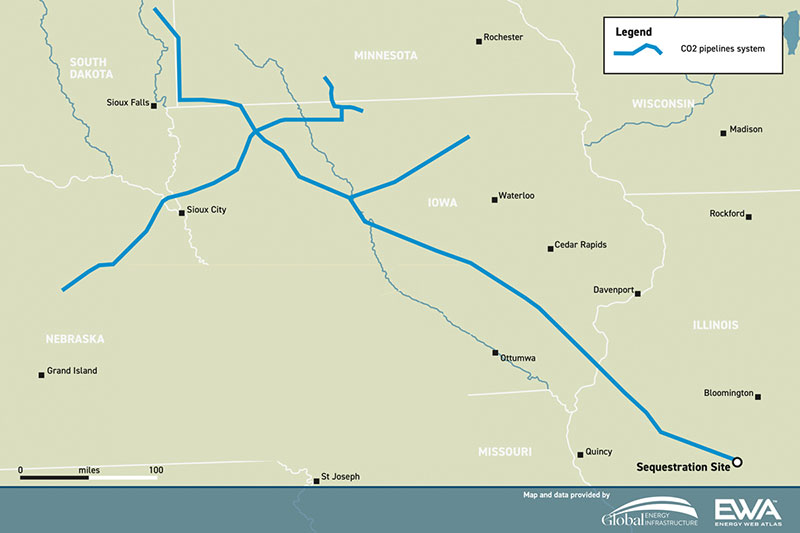February 2022, Vol. 249, No. 2
Guest Commentary
Energy Transition Spells Opportunity for Midstream Sector

By Jason Palmer, Vice President, Oil and Gas, SAP Global
These are interesting times in midstream, and it’s going to take some collective courage, creativity and calculated investment to make sure “interesting” refers to opportunities seized rather than the ominous outcomes the old “may you live in interesting times” expression portends.
There’s ample reason for optimism. Natural gas liquefied natural gas (LNG) and related products will remain vital fuels for the near future. The global push for low-to-no carbon energy solutions is driving a diversification of the product portfolio to include biofuels and hydrogen.
In the case of carbon capture, utilization and storage (CCUS), that diversification is changing the very direction in which product is transported. Serious investment in CCUS has begun, with projects announced by Exxon and Oxy, as well as Valero’s 1,200-mile (1,931-km) carbon dioxide (CO2) gathering-and-transportation pipeline network, among other examples.
Chemical companies are also pursuing CO2-derived plastics programs, and other value-added uses for the troublesome greenhouse gas will surely follow.
With these opportunities come challenges. How do you best invest in and manage a more diverse portfolio of products? How do you respond to the customer’s desire for more precise, more responsive service levels (a desire rarely accompanied by an urge to spend more on said service levels)? How do you optimize the hydrocarbon value chain – and now the carbon value chain?
Midstream’s customers will expect optimization in both as they proceed along their own energy transitions.
Being customer-centric in such an environment will hinge heavily on enlightened capital planning and, once that capital is deployed, fine-tuned asset and operations management.
With capital planning, the big challenge is how to shift investment into assets that support the energy transition. This shift will take many forms over different time horizons. In the near term, the slowdown in pipeline approvals and the emergence of hydrogen and other relatively low-volume fuel alternatives (at least for now) will increase the focus on rail, road and sea transport.
How will moves to these modes affect your service levels and their costs? Can they be vehicles to greater market share? With changing the product mix, the question extends to the strategic: Should your company compete in hydrogen or biofuels – or both – or neither?
As CCUS goes mainstream, midstream needs to understand if and how they’re going to play in the carbon value chain. That will involve transporting carbon – and not just hydrocarbons – as a new business model. Whether and when that makes sense will depend.
Do you have underused assets that could be repurposed? Can you strike up new partnerships upstream among firms looking to do enhanced oil recovery or to sequester the carbon outright? In any event, midstream, facing unprecedented complexity in its investment options, will need unprecedented visibility into its asset mix and financial status.
That visibility must extend to operations. Cost and delivery time will remain paramount among midstream customers. Ensuring profitability while maintaining quality of service across a wider breadth of services and modes will demand a degree of digitalization with which many in the industry are just now becoming acquainted.
The integration of IoT (internet of things) pipeline gauge data, capable of real-time tracking and remote adjustment related to a specific customer’s product, is one example – and one that can drive customer loyalty.
IoT, artificial intelligence and other technologies also come into play in pipeline optimization decisions that will no longer just be about maximizing flow, but rather optimizing revenue through efficient, dynamic, highly automated batching based on service-level agreements, margins or other factors.
That digitalization will extend to the back office, enabling automated sales and invoicing as part of a touchless order-to-cash process that can trim outstanding day sales and enhance customer service.
It all boils down to creating an integrated digital value chain, one that maintains real-time digital connections from hydrocarbons (or just hydrogen and carbon) through planning, engineering, operations, sales, logistics, finance and human resources.
That visibility will improve efficiency and agility, uncover blind spots that are costing you money and reveal new business opportunities. That, I think you’ll agree, is interesting – and in a very good way.
Jason Palmer is SAP’s Global Oil, Gas, and Energy industry strategy lead. SAP develops software for business management, which facilitates data processing and information flow.






Comments